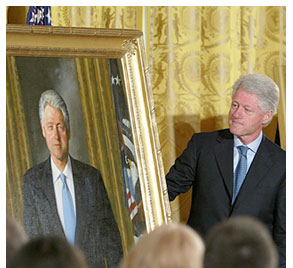Time stood still. It was a late gray morning in Washington covered with a light mist as President Reagan’s funeral cortege rode slowly up Embassy Row to the National Cathedral. For a full week, the business of government ceased, the political campaign was suspended and the relentless momentum of negative stories undermining the Bush administration skidded to a halt. Tributes to Reagan filled the airwaves. Actual history was relegated to the back pew.
Nostalgia was always the aesthetic of Reaganism — morning again for small-town life, a dream of restoring an idealized past that never existed, which would magically reappear if only we believed. Reagan’s scenario of bucolic paradise was unlike his own small-town upbringing, in which his Irish Catholic father suffered from alcoholism, was the town liberal and Democrat who did not echo the boosterism of the Republican Protestant Midwest of the 1920s, and whose chronic unemployment was resolved only by a government job with the advent of the New Deal. Nor was the small town Reagan imagined like the one in “Kings Row,” Reagan’s greatest film, in which he is literally sliced apart in its vicious undercurrents of class and intolerance. Nor was it the Babylon of Hollywood, where the divorced Reagan lived most of his adult life.
With the withdrawal of reality, President Bush sought to enter the warm haze of Reagan’s evanescent and static world. Nostalgia for Reagan became Bush’s motif. His campaign Web site was turned entirely into a Reagan memorial. Bush presented himself as the political son Reagan never had. His war on terrorism and in Iraq became the equivalent of Reagan’s Cold War.
Ken Mehlman, the president’s campaign manager, told the Iowa Republican Party Convention June 12 that Reagan had become a hovering angel. “Every time an American soldier, sailor, airman or Marine risks his or her life to ensure our security and peace, Ronald Reagan will be there,” he said. Reagan, though he once told Israeli Prime Minister Yitzhak Shamir that he had personally liberated concentration camps, in fact served during World War II at the Hal Roach Studios (known as “Fort Wacky”) in Culver City, Calif., making motivational movies such as “This Is the Army.” But long ago Reagan’s career had come to exemplify the epitaph of the classic John Ford western, “The Man Who Shot Liberty Valance”: “When the legend becomes the fact, print the legend.”
Then time started again. The campaign that had found relief nestled in Reagan’s shadow found itself in the shadow of another president. On Monday, former President Clinton and Sen. Hillary Rodham Clinton returned to the White House for the unveiling of their official portraits. They, too, had been at the Reagan funeral in the cathedral, and afterward had lunch with Britain’s Tony and Cherie Blair, the old friends meeting out of the limelight, discussing the future.
I joined a boisterous reunion of more than 200 Clinton Cabinet members (a Cabinet that looked like America), advisors, staffers, friends and Harvey Weinstein, the movie mogul of Miramax. Hardly any of us had set foot in the White House since Clinton departed. We felt completely at home, yet out of place. We had worked here every day for years and were now infidels in the temple.
The ceremony was like a Christmas truce in the trenches during World War I. Bush, who had previously denigrated his predecessor, now graciously paid tribute, listing attributes that inevitably created comparison with himself, but different from Reagan: “a deep and far-ranging knowledge of public policy, a great compassion for people in need, and the forward-looking spirit that Americans like in a president.”
Once the regal, life-size portraits were unveiled, Clinton spoke of his mixed feelings about his induction into the presidential portrait gallery. He recalled once meeting a little boy who had said, “Are you really president? But you’re not dead yet.” Obliquely but pointedly, Clinton remarked that “politics is noble work” and that we need to “return to vigorous debate about who’s right and wrong, not who’s good and bad.”
As we made our way in the receiving line from the East Room, I noticed that the Georgia O’Keeffe painting that Hillary had hung, the first and only 20th century work of modern art in the White House, was gone. In its place was a nostalgic scene of the Old West.
President Bush did not stay to receive the guests. He left the task of shaking hands and posing for photographs with the Clintons and their crowd to his wife, Laura. When the line ended, the former president and first lady met on the North Portico with dozens of members of the permanent White House staff, who clustered around them. He was getting ready for interviews about his memoir to be published next week, bottled up and eager for new campaigns. She went back to Capitol Hill to prepare, as a member of the Senate Armed Services Committee, for more hearings on torture at Abu Ghraib.
While the portrait unveiling was taking place, Bush’s press secretary, Scott McClellan, was announcing that Nancy Reagan’s plea that the administration reverse its policy inhibiting research on stem cell research (which might lead to a cure for the Alzheimer’s disease that afflicted President Reagan) had been rejected. “The policy,” he said, “remains the same.”
Nostalgia is swept away; the clock ticks; the truce is over.

